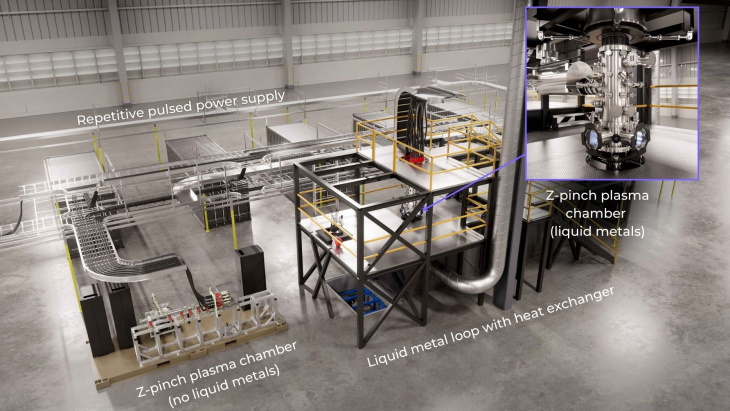Zap Energy's fusion approach - known as a sheared-flow-stabilised Z-pinch - avoids large superconducting magnets and powerful lasers, and is far smaller than conventional systems.
"From its inception, Zap Energy's founders had an idea of how a power plant based on our Z-pinch configuration would work," said Zap Vice President of Systems Engineering Matthew Thompson. "Our job is to develop and validate those plans by actually building, testing and maturing key technologies. Century is our next major step in that effort."
He added: "Zap's fusion approach is pulsed, so ultimately it will run like an internal combustion engine with cylinders firing all day long to produce steady energy output. As you do that you also generate large neutron flux and heat loads in the system over time, which is exactly the energy output that you want, but requires unique engineering solutions. Century will test a lot of our assumptions and define the best path toward our first plant."
Century is the first fully-integrated demonstration of several fusion power plant-relevant technologies, including one of the largest tests of a plasma-facing liquid metal blanket to date.
It is designed to simulate plant-like operation by: firing high-voltage pulses of power every ten seconds in a steady sequence for more than two hours; circulating 70 kilograms of hot liquid bismuth in its initial configuration and well over a tonne in its final configuration; and testing critical strategies for mitigating electrode damage due to extreme heat and neutron flux.

Century's structure (Image: Zap Energy)
Century's structure is the first to take Zap's sheared-flow-stabilised Z-pinch chamber design and orient it vertically. Pulsed power is injected through the top of the device while liquid metals circulate in a receptacle at the base. Independent test stands built over the past two years at Zap validated previous generations of each of Century's subsystems.
Century has already demonstrated a test run of more than 1000 consecutive plasmas in less than three hours into a chamber lined with flowing liquid metal. The first test of plasmas and flowing liquid metal occurred on 13 June and a few weeks later completed a run of 1080 consecutive shots.
The team is now attempting to reach a milestone outlined as part of the US Department of Energy's Milestone-Based Fusion Development Program, and hopes to do so by the end of the year.
Next year the platform will gradually ramp up to 100 kilowatts of average input power.
Zap said its sheared-flow-stabilised Z-pinch technology "provides compelling fusion economics and requires orders of magnitude less capital than conventional approaches".
"The race for fusion commercialisation has historically been thought of as a triathlon: science, then engineering, then commercialisation," said Zap CEO Benj Conway. "But at Zap, we're attempting to swim, cycle and run at the same time - such a parallel approach is key to delivering commercial fusion on a timescale that matters. Century is a vital part of the engineering leg and we're quickly coming up to speed."
Additional investment
Zap Energy also announced it has closed USD130 million of fresh capital, marking significant steps toward a commercial fusion power plant.
The Series D funding round was led by Soros Fund Management LLC, with participation by new investors that include BAM Elevate, Emerson Collective, Leitmotif, Mizuho Financial Group, Plynth Energy and Xplor Ventures. Current investors participating in the new round include Addition, Breakthrough Energy Ventures, Chevron Technology Ventures, DCVC, Energy Impact Partners, Lowercarbon Capital and Shell Ventures.
Zap said the new funding will be used to continue parallel development of both plasma R&D and systems-level plant engineering and integration, including the next generation in its FuZE device series and a cutting-edge pulsed power capacitor bank.

_18735.jpg)



_47120.jpg)

_23621.jpg)






